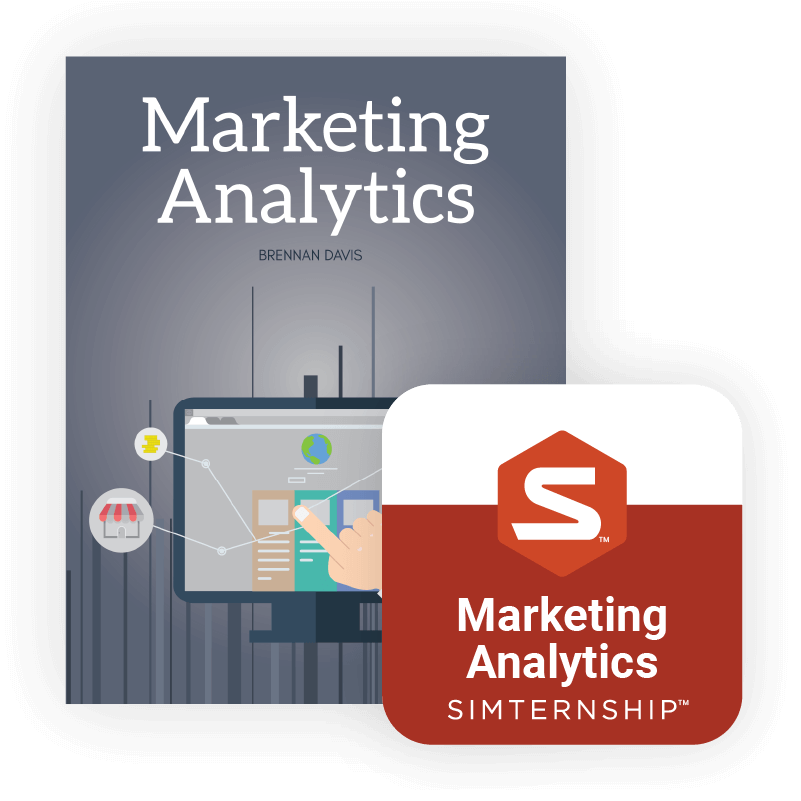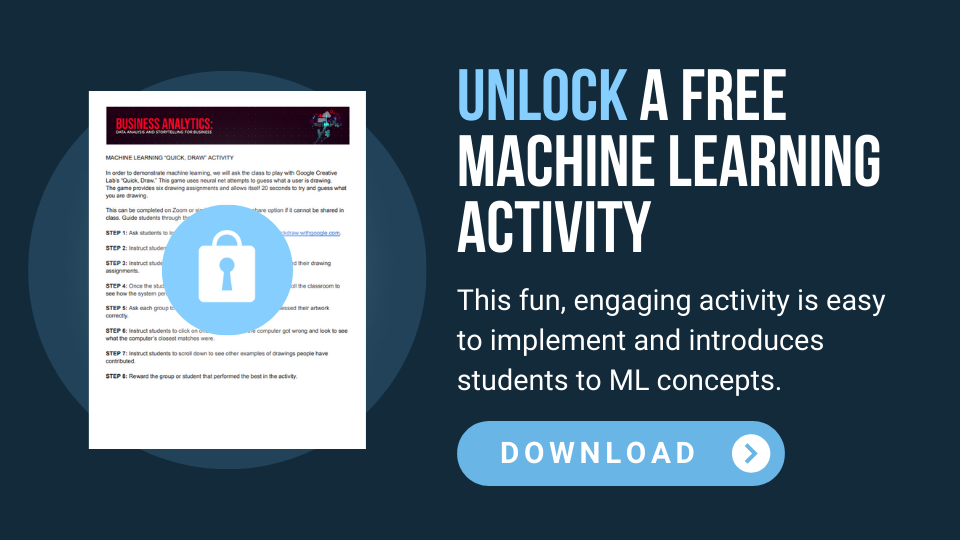Business Analytics Bundle
Business Analytics Bundle

Courseware + Simternship™
The Business Analytics Bundle helps instructors create an engaging learning environment and prepares students come to class excited to learn. This courseware isn’t a textbook, it’s a complete, turnkey business analytics curriculum with a suite of educational tools to make teaching business analytics efficient and effective.
Part of the bundle includes the all-new Stukent Business Analytics Simternship™, a robust simulation that allows students to complete job-related tasks in a real-world setting.
The “Business Analytics” courseware includes hundreds of resources for educators and pairs seamlessly with the Business Analytics Simternship.
Business Analytics Courseware
Business Analytics Courseware
Cutting-edge Business Analytics Curriculum
The “Business Analytics” courseware gives you everything you need to teach a great course. This courseware contains ready-made resources, such as lesson plans, auto-graded quizzes, more than 100 exercises, data sets, lecture slide decks, a sample course calendar, and more. It’s more than a Business Analytics textbook; it’s a whole course.
The courseware includes analytics content about marketing, accounting and finance, sales, operation and supply chain, people analytics, and more.
Author Dr. Brennan Davis provides a practical, hands-on approach to business analytics, providing you with the resources to teach an authoritative course in less prep time.

Table of Contents
Chapter 1: Business Analytics Overview
Chapter 2: Spreadsheet and Programming Tools for Business Analytics
Chapter 3: Unstructured Data and NoSQL
Chapter 4: Structured Data and SQL
Chapter 5: Data Mining with Cluster Analysis
Chapter 6: A/B Testing Essential Business Factors
Chapter 7: Machine Learning and Deep Learning
Chapter 8: Cloud Services
Chapter 9: Web Analytics
Chapter 10: Analytics for the Internet of Things
Chapter 11: Storytelling through Visualization
Chapter 12: Predictive Analytics with Regression
Chapter 13: Prescriptive Analytics with Optimization
Chapter 14: Accounting and Finance Analytics
Chapter 15: Marketing and Sales Analytics
Chapter 16: Operations and Supply Chain Analytics
Chapter 17: People Analytics
Key Learning Objectives
Demonstrate an understanding of the processes and techniques of business data collection, analysis and visualization.
Apply the logic of optimization and attribution in business analytics.
Explain the terminology and tools of business analytics.
Apply the practical tools and technique of business analytics.
Understand the roles of data technologies, data management systems and data visualization in business.
Study and practice programming tools and structured query language.
Engage in social listening and content analysis.
Understand machine learning, deep learning, and artificial intelligence.
Run field experiments in digital environments, including A/B testing.
Understand, run, and interpret results of predictive models.
Educator Resources
The courseware’s materials make teaching business analytics easier for you and more engaging for students. The following resources are included:
Auto-graded quizzes for each chapter
20 data sets
100+ exercises
Exercises for Python, Excel, R, Tableau
4 Expert Sessions
Lecture slide decks
Lesson plans
Real-world examples
Sample syllabus and course calendars
LMS integration with Stukent platforms
Chapter 1: Business Analytics Overview
Chapter 2: Spreadsheet and Programming Tools for Business Analytics
Chapter 3: Unstructured Data and NoSQL
Chapter 4: Structured Data and SQL
Chapter 5: Data Mining with Cluster Analysis
Chapter 6: A/B Testing Essential Business Factors
Chapter 7: Machine Learning and Deep Learning
Chapter 8: Cloud Services
Chapter 9: Web Analytics
Chapter 10: Analytics for the Internet of Things
Chapter 11: Storytelling through Visualization
Chapter 12: Predictive Analytics with Regression
Chapter 13: Prescriptive Analytics with Optimization
Chapter 14: Accounting and Finance Analytics
Chapter 15: Marketing and Sales Analytics
Chapter 16: Operations and Supply Chain Analytics
Chapter 17: People Analytics
Demonstrate an understanding of the processes and techniques of business data collection, analysis and visualization.
Apply the logic of optimization and attribution in business analytics.
Explain the terminology and tools of business analytics.
Apply the practical tools and technique of business analytics.
Understand the roles of data technologies, data management systems and data visualization in business.
Study and practice programming tools and structured query language.
Engage in social listening and content analysis.
Understand machine learning, deep learning, and artificial intelligence.
Run field experiments in digital environments, including A/B testing.
Understand, run, and interpret results of predictive models.
The courseware’s materials make teaching business analytics easier for you and more engaging for students. The following resources are included:
Auto-graded quizzes for each chapter
20 data sets
100+ exercises
Exercises for Python, Excel, R, Tableau
4 Expert Sessions
Lecture slide decks
Lesson plans
Real-world examples
Sample syllabus and course calendars
LMS integration with Stukent platforms
Business Analytics Simternship
Business Analytics Simternship

Take Learning Beyond the Book with a Simternship
The Stukent Business Analytics Simternship goes beyond your average business simulation, allowing your students to apply the concepts you teach them in a real-world setting. Students will have hands-on experiences transforming and interpreting data in various business scenarios that teach them to connect all stages of data analytics.
A Simternship helps your students gain experience, master marketable skills, increase their knowledge retention, and yes, even make mistakes in a low-risk environment. It’s a powerful experience that cements learning for a lifetime.
Simternship Scenario
In the Stukent Business Analytics simulation, students get hands-on experience with crucial analytics concepts, tools, and practices in the business world. Students are a new business analyst at Buhi Supply Co. helping the company improve its decision-making with data.
Over the course of the simulation’s nine rounds, students will have hands-on experiences transforming and interpreting data in various business scenarios that teach them to connect all stages of data analytics: data transformation/integration, cluster analysis, visualization/storytelling, and A/B testing.
Round Descriptions
Round 1: Learn the Fundamentals
Scenario: Buhi needs help completing information missing from its data dictionary, cleaning internal data, and summarizing the findings from a third-party report.
Round 2: Query and Clean Financial Data
Scenario: Buhi’s finance department needs your help running queries and cleaning the resulting financial data. Then, they’ll need you to help update the P&L section of the quarterly business report.
Round 3: Transform and Integrate Accounting Data
Scenario: Buhi’s accounting department needs your help running queries and cleaning the resulting accounting data. Then, they’ll need you to help update the financials section of the next QBR.
Round 4: Perform Cluster Analysis of Supply Chain Data
Scenario: The supply chain department needs your help improving Buhi’s inventory policy. To do that, you’ll need to submit a data request to IT and then follow up to ensure the usefulness of the data. After that, you will perform a series of cluster analyses on the returned data to make recommendations for the supply chain manager.
Round 5: A/B Test Human Resources Campaigns
Scenario: The human resources department needs you to help increase employee engagement by collecting data for internal campaigns. They’ll also need you to help them update the human resources section of the quarterly business report.
Round 6: Set up a Cloud Services for the Sales Team
Scenario: After recommending an employee-engagement email to HR, you’ll collaborate with the sales team to select and implement a cloud-based services solution. You will also update the customer experience section of the quarterly business review.
Round 7: Establish Metrics and Troubleshoot QA Issues
Scenario: The product engineering team needs your help setting up appropriate business metrics for a new product, then identifying the data sources needed to calculate those metrics. Likewise, the quality assurance team needs you to identify the causes of two recurring warranty claims and, if possible, make recommendations to fix them.
Round 8: Update the Quarterly Business Report
Scenario: Buhi needs you to update every section of the QBR for the latest quarter using data cleaned and provided for you by each department.
Round 9: Present the Quarterly Business Report
Scenario: The business division leadership team needs you to prepare and deliver to them the QBR presentation for the latest quarter.
Key Learning Objectives
During this simulation, your students will perform the following activities:
Execute the processes and techniques of data collection and cleaning.
Perform data analysis and present results as impactful visualizations.
Design winning strategies using A/B testing.
Solve business problems by using data technologies and data management systems.
Identify data types based on observed values.
Employ Structured Query Language (SQL) for business decision-making.
Implement a k-means cluster analysis after classifying its necessary data inputs.
Demonstrate the benefits of cloud services, and use them to support business activities.
Apply analytics principles to concrete scenarios, such as working with Internet of Things (IoT) devices.
Practice effective communication regarding analytics, including report writing and verbal presentations.
In the Stukent Business Analytics simulation, students get hands-on experience with crucial analytics concepts, tools, and practices in the business world. Students are a new business analyst at Buhi Supply Co. helping the company improve its decision-making with data.
Over the course of the simulation’s nine rounds, students will have hands-on experiences transforming and interpreting data in various business scenarios that teach them to connect all stages of data analytics: data transformation/integration, cluster analysis, visualization/storytelling, and A/B testing.
Round 1: Learn the Fundamentals
Scenario: Buhi needs help completing information missing from its data dictionary, cleaning internal data, and summarizing the findings from a third-party report.
Round 2: Query and Clean Financial Data
Scenario: Buhi’s finance department needs your help running queries and cleaning the resulting financial data. Then, they’ll need you to help update the P&L section of the quarterly business report.
Round 3: Transform and Integrate Accounting Data
Scenario: Buhi’s accounting department needs your help running queries and cleaning the resulting accounting data. Then, they’ll need you to help update the financials section of the next QBR.
Round 4: Perform Cluster Analysis of Supply Chain Data
Scenario: The supply chain department needs your help improving Buhi’s inventory policy. To do that, you’ll need to submit a data request to IT and then follow up to ensure the usefulness of the data. After that, you will perform a series of cluster analyses on the returned data to make recommendations for the supply chain manager.
Round 5: A/B Test Human Resources Campaigns
Scenario: The human resources department needs you to help increase employee engagement by collecting data for internal campaigns. They’ll also need you to help them update the human resources section of the quarterly business report.
Round 6: Set up a Cloud Services for the Sales Team
Scenario: After recommending an employee-engagement email to HR, you’ll collaborate with the sales team to select and implement a cloud-based services solution. You will also update the customer experience section of the quarterly business review.
Round 7: Establish Metrics and Troubleshoot QA Issues
Scenario: The product engineering team needs your help setting up appropriate business metrics for a new product, then identifying the data sources needed to calculate those metrics. Likewise, the quality assurance team needs you to identify the causes of two recurring warranty claims and, if possible, make recommendations to fix them.
Round 8: Update the Quarterly Business Report
Scenario: Buhi needs you to update every section of the QBR for the latest quarter using data cleaned and provided for you by each department.
Round 9: Present the Quarterly Business Report
Scenario: The business division leadership team needs you to prepare and deliver to them the QBR presentation for the latest quarter.
During this simulation, your students will perform the following activities:
Execute the processes and techniques of data collection and cleaning.
Perform data analysis and present results as impactful visualizations.
Design winning strategies using A/B testing.
Solve business problems by using data technologies and data management systems.
Identify data types based on observed values.
Employ Structured Query Language (SQL) for business decision-making.
Implement a k-means cluster analysis after classifying its necessary data inputs.
Demonstrate the benefits of cloud services, and use them to support business activities.
Apply analytics principles to concrete scenarios, such as working with Internet of Things (IoT) devices.
Practice effective communication regarding analytics, including report writing and verbal presentations.
Industry Expert Reviews

Anirudh Krishna - Senior Data Analyst
"This book clearly breaks down the concepts of Business Analytics which are essential for successful strategies. Professor Davis' insights about A/B testing and other analytics tools are simple and easy to relate to real-world applications."

David Cornella - Senior Data Analyst
"This textbook breaks down many fundamentals of business analytics and provides students with a pragmatic approach to solving real-world business problems."

Arjun Reddy - Data Scientist
“The textbook covers a diverse range of topics, all of which are essentials to become a modern Analytics programmer and a Data Scientist, from SQL and tools like R, Excel and Python to NoSQL; from A/B Testing and Cluster analysis to Machine learning and predictive analytics. I particularly like the inclusion of Analytics for Internet of Things and Cloud Services topics, which are not very often talked about, in context of business analytics. Dr. Davis' book is a stepping stone to anyone who aims to develop skills to efficiently use tools, business-specific application, involve in the future of analytics, and build solutions at scale.”

Alex Dowthwaite - Product Analyst
“Dr. Davis's textbook highlights key data visualization and analytics tools that data-centric companies are eagerly searching for in potential employees.”

Sally Nguyen - Data Analyst
“I find that many people overlook the power of Excel in favor of new coding languages such as Python and R. However, Excel is a foundational analysis tool, especially because it is readily available and there is a low barrier to entry. I love the fact that this book dedicates an entire chapter to Excel.”

Nate Veldkamp - Senior Manager, Analytics
“Technology’s rate of change in business over the last decade has outpaced the curriculum of most university business programs when it comes to business analytics and the tools and knowledge needed to effectively drive data-driven decisions. Dr. Brennan Davis’s close connections with analytics leaders at today’s top companies ensure his content is up to date with the needs of industry and his book and courseware provide a modern platform to teach the foundational topics of business analytics.”

Kate Belotti - Business Technology Analyst
“A great pairing of the functional and technical skills needed to understand the tools of today.”

Dmytro Marushkevych - Sr. Director Data Science & Analytics
“Professor Davis' book has a very strong coverage of the key tools and concepts required in the field of business analytics: from Excel (most underestimated and under-used analytical tool), to Web Analytics, to Data Mining, to Deep Learning. I wish all the candidates I am interviewing had this toolset at their disposal.”

Noah Wang - Cloud Applications Consultant
“This book proactively prepares individuals for the digital transformation that is coming to the global economy. With foundational and applicable knowledge of predictive analytics and cloud computing, learners are prepared to be a part of the biggest technological advancement since the internet.”

Noah MacDonald - Web Solutions Engineer
“Brennan Davis has a unique way of introducing the reader to highly related fields that are seldom taught together into an exhaustive text for anyone seeking to understand the problems being solved by modern Analytics & Reporting organizations and teams. The examples are pragmatic, reflective of Davis' extensive experience outside the classroom, and delivered by a natural educator.”
About The Author

Brennan Davis
Dr. Brennan Davis is Professor and Director of the Master of Science for Business Analytics program at the Orfalea College of Business at California Polytechnic State University. He has over a decade of experience developing curriculum for business and several years of experience teaching business analytics in the classroom. Professionally, he has eight years of experience in business management in the automotive and technology industries.
He spent years developing the business analytics course with a committee of executives from top local business agencies and from top businesses in the Silicon Valley. The course covers data approaches useful to business analytics professionals, advanced analysis that firms most desire when hiring students, and visualization techniques helpful in communicating as a business liaison between technology experts and company managers.

Brennan Davis
Dr. Brennan Davis is Professor and Director of the Master of Science for Business Analytics program at the Orfalea College of Business at California Polytechnic State University. He has over a decade of experience developing curriculum for business and several years of experience teaching business analytics in the classroom. Professionally, he has eight years of experience in business management in the automotive and technology industries.
He spent years developing the business analytics course with a committee of executives from top local business agencies and from top businesses in the Silicon Valley. The course covers data approaches useful to business analytics professionals, advanced analysis that firms most desire when hiring students, and visualization techniques helpful in communicating as a business liaison between technology experts and company managers.
Hands-on Learning without the Hassle
Stukent Simternships integrate with your favorite LMS platforms
Single Sign-on
Grade Book Syncing
Deep Linking
Rostering









